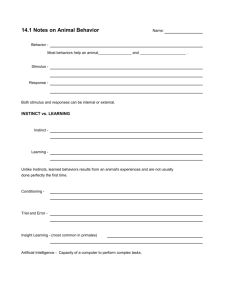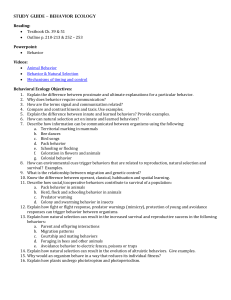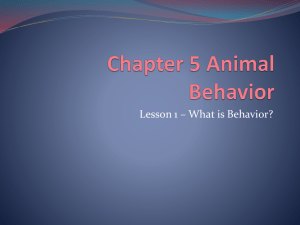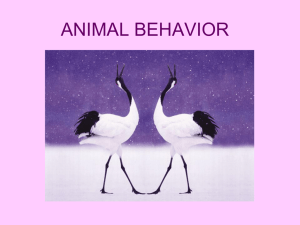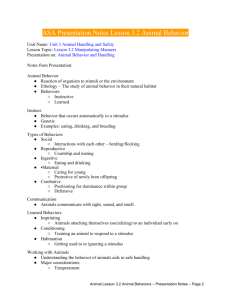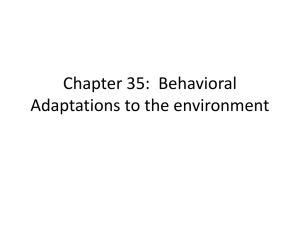Animal Behavior
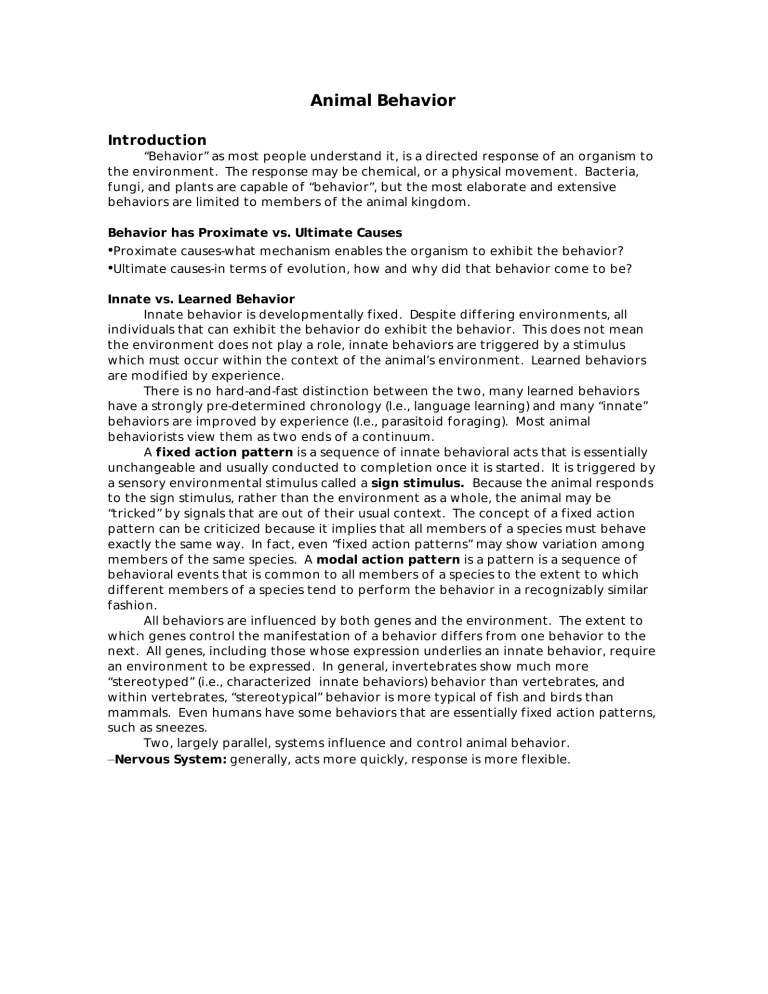
Animal Behavior
Introduction
“Behavior” as most people understand it, is a directed response of an organism to the environment. The response may be chemical, or a physical movement. Bacteria, fungi, and plants are capable of “behavior”, but the most elaborate and extensive behaviors are limited to members of the animal kingdom.
Behavior has Proximate vs. Ultimate Causes
• Proximate causes-what mechanism enables the organism to exhibit the behavior?
• Ultimate causes-in terms of evolution, how and why did that behavior come to be?
Innate vs. Learned Behavior
Innate behavior is developmentally fixed. Despite differing environments, all individuals that can exhibit the behavior do exhibit the behavior. This does not mean the environment does not play a role, innate behaviors are triggered by a stimulus which must occur within the context of the animal’s environment. Learned behaviors are modified by experience.
There is no hard-and-fast distinction between the two, many learned behaviors have a strongly pre-determined chronology (I.e., language learning) and many “innate” behaviors are improved by experience (I.e., parasitoid foraging). Most animal behaviorists view them as two ends of a continuum.
A fixed action pattern is a sequence of innate behavioral acts that is essentially unchangeable and usually conducted to completion once it is started. It is triggered by a sensory environmental stimulus called a sign stimulus. Because the animal responds to the sign stimulus, rather than the environment as a whole, the animal may be
“tricked” by signals that are out of their usual context. The concept of a fixed action pattern can be criticized because it implies that all members of a species must behave exactly the same way. In fact, even “fixed action patterns” may show variation among members of the same species. A modal action pattern is a pattern is a sequence of behavioral events that is common to all members of a species to the extent to which different members of a species tend to perform the behavior in a recognizably similar fashion.
All behaviors are influenced by both genes and the environment. The extent to which genes control the manifestation of a behavior differs from one behavior to the next. All genes, including those whose expression underlies an innate behavior, require an environment to be expressed. In general, invertebrates show much more
“stereotyped” (i.e., characterized innate behaviors) behavior than vertebrates, and within vertebrates, “stereotypical” behavior is more typical of fish and birds than mammals. Even humans have some behaviors that are essentially fixed action patterns, such as sneezes.
Two, largely parallel, systems influence and control animal behavior.
–
Nervous System: generally, acts more quickly, response is more flexible.
– Endocrine System : generally, acts over a greater duration, responses are more stereotyped (unless modified by nervous system).
• Many behaviors have input from both systems.
Even simple, one-celled organisms are capable of behavior.
For instance, the protozoan, Euglena gracilis , will move in the direction of weak light, though it has no nervous or endocrine system.
Learning
Learning can be defined as a more or less permanent change in the behavior or potential behavior of an animal based upon experience. Learning is pervasive in the behavior of birds and mammals, but other animals are capable of learning as well.
There is no hard and fast distinction between learned and instinctive behavior.
Learning can act to modify species-specific fixed action patterns. Most innate behaviors improve with performance as the animals learn to carry them out efficiently.
One type of learning is imprinting. Imprinting occurs when an animal learns to make a particular response to a particular object. This process is very rapid. The usual pattern is an “instantaneous” and “irreversible” alteration of behavior. Some examples of imprinting include filial imprinting and sexual imprinting.
Filial imprinting is the process by which animals develop a social attachment to a particular object. For example, mallard ducks will imprint upon any obvious stimulus
(ducks, other birds, people, flashing lights) as “mother”, and will follow this stimulus for the duration of their early development. Filial imprinting occurs during a fixed window of time called a “sensitive period”.
Sexual imprinting is the process by which animals learn to direct their sexual behavior at particular objects or stimuli. For example, birds such as mallards and zebra finches will imprint upon the birds they are raised with during the first few weeks of life. Cross fostered birds attempt to court the “wrong” species.
Associative learning is the process by which an animal comes to associate events in its environment with consequences or objects with stimuli. Formerly it was approached from a “reflex-response” point of view, though it is becoming clear that most animals have a “world view” in which they track a variety of stimuli and are likely to associate particular events with stimuli that might have adaptive significance. For instance, rats will learn to associate feelings of nausea with particular smells, but not with flashing lights. This makes perfect sense in light of the fact that flashing lights would have no relationship to nausea in a rat’s natural environment. Classical conditioning is the process by which an organism learns to associate a stimulus in the environment with the normal flow of cause and effect, operant conditioning is the mechanism by which an organism learns to associate its own behavior with a result.
Habituation is the relatively persistent waning of a response to a stimulus when the expected result does not occur.
Sensory Adaptation is sometimes called habituation, it is the phenomenon where environmental “noise” is filtered out by the nervous system over time and the animal no longer responds to it. Sensitization is the growing sensitivity of an animal
to repeated stimuli. In essence, it is the opposite of sensory adaptation-it occurs when the stimulus is rewarded or is of adaptive significance. A search image is an image an animal becomes especially adept at recognizing, as a result of repeatedly searching for it and being rewarded for finding it.
Cognition
The extent to which animals “think” is unknown, although it is becoming increasingly obvious that the human mind differs from those of other animals largely by the extent of our cognitive ability, rather than the simple rule “humans think, animals don’t”.
Some hallmarks of cognitive ability
• ability to classify
• ability to recognize attributes of objects
• ability to count
• ability to remember the locations of objects in space
• ability to use language
Play
Most mammals, some birds, and possibly some other animals (including elephantnosed fish) exhibit play behavior. “Play” is an inexact term that covers a range of behaviors exhibited by young animals.
– 1) social play-such as wrestling and chasing other animals
– 2) exercise play-such as running, hanging from tree limbs, etc..
– 3) object oriented play-involves manipulating a novel object
The most obvious thing these behaviors have in common is that they have no immediate adaptive value. It is frequently hypothesized that the function of play behaviors is to practice adult activities in a context where the consequences of failure are not serious or fatal. Play behaviors frequently take a great deal of time and energy,
(I.e., Byer’s study of antelopes), and it is unlikely that they have no adaptive function at all. Play behaviors may also be used to gather information. For instance, primates may
“play fight” as youngsters and establish their relative positions in the dominance heirarchy.
Some Kinds of Behavior kinesis (moves more/less in response to stimulus) and taxis (moves to/away from stimulus) cognitive maps -animal uses cognition to take shortest trip, to plan shortest route, or to remember location of objects.
use of landmarks -animal orients behavior patterns to objects in the environment migration -seasonal movement of individuals or whole populations dormancy -seasonal or environmentally induced slowdown of metabolism antipredator behavior/ predatory behavior courtship social sehaviorsagnostic behaviors-aggressive interactions-cooperative foraging
– communication
Example of Kinesis
Paramecium caudatum is a one-celled cilliate protozoa (not an animal) that feeds on bacteria. It has no brain, but it does respond to the concentration of food. In areas with high densities of bacteria, Paramecia move more slowly and turn more frequently.
This causes them to concentrate in areas where food is available.
Example of Taxis
“Phototaxis” is the movement of an organism toward/away from light. Euglena gracilis is a one celled photosynthetic protozoan. Euglena has an “eyespot” that orients it toward dim light, and causes it to move in the appropriate direction. This occurs because of another structure, called a “stigma” which casts a shadow. Whenever the stigma casts a shadow on the eyespot, the cell arches the flagellum, causing a change in direction.
Example of Feeding Behavior
Bumblebees visit flowers, collecting pollen and nectar. Nectar is food for themselves and the bees in the colony. Pollen and nectar are used to the developing larvae in the colony. Pollen is brought back on specialized hairs, called corbicula.
Nectar is brought home in their honey crop.
Bumblebees seek to collect as much food as possible in the shortest time. For some flowers, such as monkshod, the bee must crawl into the flower itself to get the nectar reward. This is time consuming. Experienced foragers learn to chew through just the right part of the flower to get to the reward with less work. This is both a learned, and an instinctive behavior. Is it cognition?
Example of Social Behavior
Workers of the army ant, Echtion sp . will form a bridge with their bodies when the colony is confronted with an obstacle. The entire colony, including the queen and workers carrying the larvae, will cross the workers. Unlike kinesis or taxis, this is a very complex behavior that requires the concerted efforts of thousands of individuals.
Interestingly, no single insect is really “aware” of what it is doing.
Pre-Lab Questions
1) Look up several (6-10) examples of animal behavior that have been studied from an evolutionary point of view, list and describe the proximate and ultimate causes. In your list, include; alarm calls in ground squirrels, mate choice in widow birds, social behavior in African wild dogs, orientation and use of landmarks in wasps.
Questions for Discussion
A) Compare some of the experiments used to determine the cognitive abilities of various animals.
–
Is it possible to devise an experiment to determine whether grey parrots can distinguish between music genres such as metal, electronica, and hip hop?
– Is it possible to devise an experiment to determine whether parrots can distinguish between “moral” and “immoral” behavior?
B) Behavior is sometimes called the “pacemaker” for evolution. Why might this be the case?
A) Name some responses of plants, bacteria, fungi, and protozoa, that resemble behavior and describe the proximate and ultimate causes.
Laboratory Exercise
The sciences of ethology, behavioral ecology, endocrinology, and neurobiology all study animal behavior. A behavior is a response to the environment by the organism. endocrinologists and neurobiologists study the proximate causes of behavior, ethologists study and categorize the types of behaviors and investigate their significance in terms of the world around the animal, and behavioral ecologists study the ultimate evolutionary cause of behaviors.
Biotic and abiotic factors are limiting factors that control the maximum size of a given population. Favorable conditions are desired by an organism of its home environment. Because of this, an animal must search for the environment to fit its structure and lifestyle. This is called habitat selection. An animal can display many different types of behaviors, two being taxis and kinesis. Taxis behaviors are deliberate movements toward or away from a stimulus. Kinesis is a random movement that is not oriented toward or away from a stimulus. Taxis behaviors are exemplary of the physiological needs of an organism. Other behaviors are agonistic, aggressive or submissive actions toward another organism; or mating behaviors. One of the most basic tasks in science is observation. Observation allows us to form hypothesis that might ultimately be testable. This laboratory will consist of three separate sections.
You may do them in any order you wish. Take notes on all your observations.
Part One: Euglena Observations
Euglena gracilis is a one-celled protozoan. Early biologists spent a lot of time arging over whether it is a plant or an animal. It moves around like an animal, but it photosynthesizes like a plant. In fact, it is neither plant nor animal, it is a member of its own kingdom, the euglenazoa. Euglena gracilis exhibits an interesting response to light.
Observe Euglena gracilis under the microscope and record your observations:
Now examine the Euglena under the dissecting scope (note the much smaller magnification). How are they distributed in the column of water suspended in the pipette?
The Euglena will be placed in an environment where dim light is coming from one direction, for 25 minutes. Now examine the euglena in the column of water. How are they distributed? What is happening? What type of behavior is this?
Part Two: Isopod Behavior Exercise
To observe animal behavior in this lab, isopods will be isolated in a controlled environment. Isopods, more commonly known as pill bugs, are crustaceans with a hard exoskeleton, seven pairs of legs, and antenna. Members of the oniscidea order of isopods have evolved to live on land. Your pillbugs are probably Armadillidium vulgare , or Poricello sp ., both are common garden species.
Directions:
Select a pillbug from the pillbug habitat and let it crawl around on your hand for a bit, if it refuses to budge, place it on your desk and let it crawl for a while. Record your observations in the space below:
Draw a sketch of your pillbug-
Develop some ideas about pillbug behavior. What do they like/dislike? To what stimuli are they likely to respond? Do they like light? Moisture? Do they like to be beheath things?
Think of a way it might be possible to test your hypothesis. As a group, come up with ways to test some of your hypotheses about pillbug behavior. One idea is to use the pillbug maze, configuring some ideas so they are light vs. dark or wet vs. dry. You can also test to see whether pillbugs prefer to be alone or with other pillbugs.
Next, place your pillbugs in the pillbug maze and see what they do. Consider recording the actions of a particular pillbug every thirty seconds. Record your results below:
Was your hypothesis supported? Rejected? Need more experiments?
Interpret your results in the context of pillbug ecology.
Part Three: Urban wildlife
For this exercise, you and a lab partner will need to leave the lab room and go outside as a team. In the urban environment, locate an animal or group of animals.
Observe their behavior for fifteen minutes. One partner should take a log of everything the animal does. The other partner should focus on a single behavior and note the time at which every instance of the behavior occurs and how it is directed.
Use a watch, and be careful to observe the animals from a distance so as not to disturb them.
Some excellent urban animals; pigeons, grey squirrels, starlings, house sparrows, houseflies, spiders.
Be prepared to discuss what you saw in terms of the adaptive context of the behavior.
Record your observations below.
How might the behavior of this animal enable it to survive and reproduce in the urban environment?
